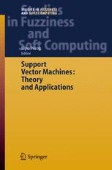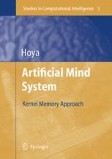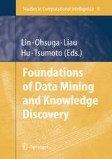Search
Search Results
-
Kernel Discriminant Learning with Application to Face Recognition
When applied to high-dimensional pattern classification tasks such as face recognition, traditional kernel discriminant analysis methods often suffer...
-
Support Vector Machines – An Introduction
This is a book about learning from empirical data (i.e., examples, samples, measurements, records, patterns or observations) by applying support...
-
Active Support Vector Learning with Statistical Queries
The article describes an active learning strategy to solve the large quadratic programming (QP) problem of support vector machine (SVM) design in...
-
Tachycardia Discrimination in Implantable Cardioverter Defibrillators Using Support Vector Machines and Bootstrap Resampling
Accurate automatic discrimination between supraventricular (SV) and ventricular (V) tachycardia (T) in implantable cardioverter defibrillators (ICD)...
-
Multiple Model Estimation for Nonlinear Classification
This chapter describes a new method for nonlinear classification using a collection of several simple (linear) classifiers. The approach is based on...
-
Sensation and Perception Modules
In any kind of creature, both the mechanisms of sensation and perception are indispensable for continuous living, e.g. to find edible plants/fruits...
-
Language and Thinking Modules
In this chapter, we focus upon the two modules which are closely tied to the concept of “action planning”, i.e. the 1) language and 2) thinking...
-
Modelling Abstract Notions Relevant to the Mind and the Associated Modules
This chapter is devoted to the remaining four modules within the AMS, i.e. 1) attention, 2) emotion, 3) intention, and 4) intuition module, and their...
-
From Classical Connectionist Models to Probabilistic/Generalised Regression Neural Networks (PNNs/GRNNs)
This chapter begins by briefly summarising some of the well-known classical connectionist/artificial neural network models such as multi-layered...
-
The Kernel Memory Concept – A Paradigm Shift from Conventional Connectionism
In this chapter, the general concept of kernel memory (KM) is described, which is given as the basis for not only representing the general notion of...
-
The Mathematics of Learning: Dealing with Data *
Learning is key to developing systems tailored to a broad range of data analysis and information extraction tasks. We outline the mathematical...
-
Web Page Classification*
This chapter describes systems that automatically classify web pages into meaningful categories. It first defines two types of web page...
-
A New Theoretical Framework for K-Means-Type Clustering
One of the fundamental clustering problems is to assign n points into k clusters based on the minimal sum-of-squares(MSSC), which is known to be...
-
On Statistical Independence in a Contingency Table
This paper gives a proof showing that statistical independence in a contingency table is a special type of linear independence, where the rank of a...
-
First-Order Logic Based Formalism for Temporal Data Mining*
In this article we define a formalism for a methodology that has as purpose the discovery of knowledge, represented in the form of general Horn...
-
A Probabilistic Logic-based Framework for Characterizing Knowledge Discovery in Databases
In order to further improve the KDD process in terms of both the degree of automation achieved and types of knowledge discovered, we argue that a...
-
Cluster Identification Using Maximum Configuration Entropy
Clustering is an important task in data mining and machine learning. In this paper, a normalized graph sampling algorithm for clustering that...
-
Identification of Critical Values in Latent Semantic Indexing
In this chapter we analyze the values used by Latent Semantic Indexing (LSI) for information retrieval. By manipulating the values in the Singular...
-
An Algorithm to Calculate the Expected Value of an Ongoing User Session
The fiercely competitive web-based electronic commerce environment has made necessary the application of intelligent methods to gather and analyze...
-
Justification and Hypothesis Selection in Data Mining
Data mining is an instance of the inductive methodology. Many philosophical considerations for induction can also be carried out for data mining. In...
